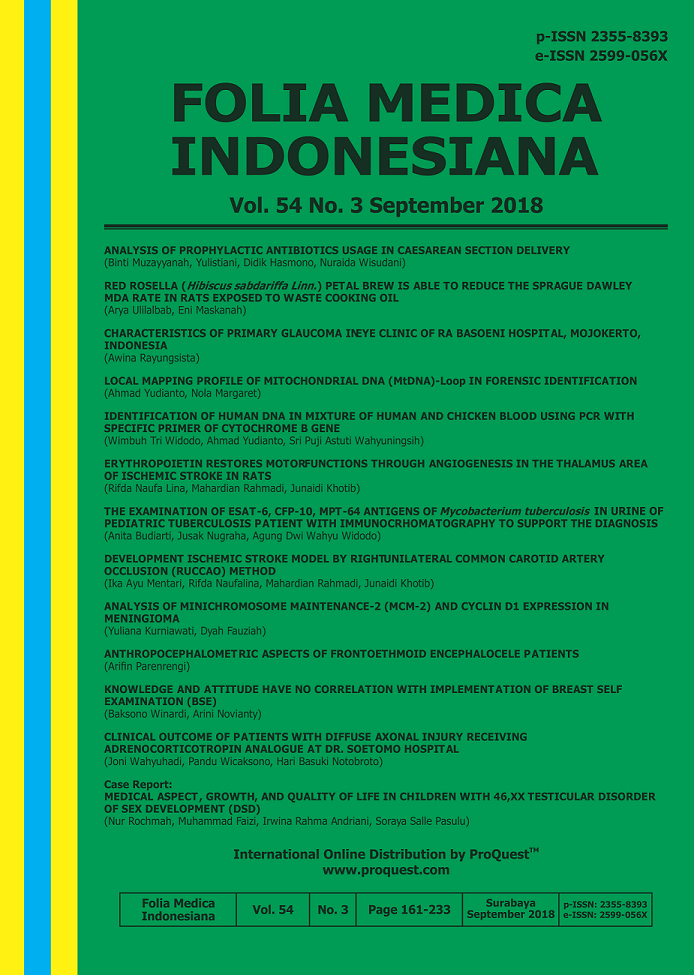Main Article Content
Abstract
Keywords
Article Details
-
Folia Medica Indonesiana is a scientific peer-reviewed article which freely available to be accessed, downloaded, and used for research purposes. Folia Medica Indonesiana (p-ISSN: 2541-1012; e-ISSN: 2528-2018) is licensed under a Creative Commons Attribution 4.0 International License. Manuscripts submitted to Folia Medica Indonesiana are published under the terms of the Creative Commons License. The terms of the license are:
Attribution ” You must give appropriate credit, provide a link to the license, and indicate if changes were made. You may do so in any reasonable manner, but not in any way that suggests the licensor endorses you or your use.
NonCommercial ” You may not use the material for commercial purposes.
ShareAlike ” If you remix, transform, or build upon the material, you must distribute your contributions under the same license as the original.
No additional restrictions ” You may not apply legal terms or technological measures that legally restrict others from doing anything the license permits.
You are free to :
Share ” copy and redistribute the material in any medium or format.
Adapt ” remix, transform, and build upon the material.

References
- Arora J, Kumar G, Verma AK, Bhalla M, Sarin R, Myneedu VP (2015). Utility of MPT64 antigen detection for rapid Confirmation of Mycobacterium tuberculosis Complex. J Glob Infect Dis 7, 66-69
- Bekmuryazeva A, Sypabekova M, Kanayeva D (2013). Tuberculosis diagnosis using immunodominant, secre-ted antigens of Mycobacterium tuberculosis. Tubercu-losis, 1-8
- Flynn J, Chan J, Lin P (2011). Macrophage and control of granulomatous inflammation in tuberculosis. Muco-sal Immunol 4, 271-8
- Ganguly N, Sharma P (2012). Mycobacterium tubercu-losis RD-1 secreted antigen as protective and risk factor for tuberculosis. Dalam buku undersstanding tuberculosis–Global experience and innovative approaches to the diagnosis rijeka. Croasia, Intech publisher
- Gustiani N, Parwaati I, Tjandrawati A, Lismayanti L (2014). Validitas pemeriksaan complex spesific anti-gen Mycobacterium tuberculosis region of difference 1-3 metode rapid immunocromatographypada sputum penderita tuberculosis paru. Majalah Kedokteran 46
- Kleinnijenhuis J, et al (2011). Innate immune recogni-tion of Mycobacterium tuberculosis. Hindawi Publish-ing Corporation Clinical and Developmental Immu-nology 2011
- Krishnan N, Robertson BD, Thwaites G (2010). The mechanisms and concequences of the extra-pulmonary disemination of Mycobacterium tuberculosis. Tuber-culosis (edinb) 90, 361-6
- Ministry of Health of Republic of Indonesia (2013). Petunjuk Teknis Manajemen TB anak, 2-79
- Notoatmodjo (2012). Metodologi penelitian kesehatan, Edisi Revisi. Jakarta, Rineke Xipta, p 35-43
- Noussair L, Bert FDR, Leflon-Guibout, Gayet N, Ni-cholas-Chanoine MH (2009). Early diagnosis of extrapulmonary tuberculosis by anew procedure com-bining broth culture and PCR. J of Clin Micro 47,1452-7
- Raviglione M, O'Brien R (2012). Tuberculosis. In: LoMc Graw Hill; ngo D, Kasper D, Jameson J, Fauci A, Hauser S, Loscalzo J, editor. Harrisons Principles of Internal Medicine. New York, The McGraw Hill, p 1340-1359
- Sari SR (2011). Nilai diagnostik antigen TB dengan Rapid Test Device (TbAg) untuk tuberkulosis paru. Unpublished thesis. Surabaya, Faculty of Medicine, Universitas Airlangga
- Smith I (2003). Mycobacterium tuberculosis pathogene-sis and molecular determinants of virulence. Clin Microbiol Rev 16, 463-96
- Thomas CE, Sexton W, Benson K, et al (2010). Urine collection and processing for protein biomarker. American Association for Cancer Research 19, 953-9
- Tuuminen T (2012). Urine as a specimen to diagnose infections in twenty first century: focus on analytical accuracy. Immunology 3, 1-6
- Wahyuningsih E (2014). Pola klinik tuberkulosis paru di RSUP Dr. Kariadi, Semarang Periode Juli 2012-Agustus 2013. Jurnal Media Medika Muda 3, 1-19
- Yusa, Maniam MBS (2016). Aktif dan kreatif belajar biologi. Bandung, Grafindo media pratama, p 149-153
References
Arora J, Kumar G, Verma AK, Bhalla M, Sarin R, Myneedu VP (2015). Utility of MPT64 antigen detection for rapid Confirmation of Mycobacterium tuberculosis Complex. J Glob Infect Dis 7, 66-69
Bekmuryazeva A, Sypabekova M, Kanayeva D (2013). Tuberculosis diagnosis using immunodominant, secre-ted antigens of Mycobacterium tuberculosis. Tubercu-losis, 1-8
Flynn J, Chan J, Lin P (2011). Macrophage and control of granulomatous inflammation in tuberculosis. Muco-sal Immunol 4, 271-8
Ganguly N, Sharma P (2012). Mycobacterium tubercu-losis RD-1 secreted antigen as protective and risk factor for tuberculosis. Dalam buku undersstanding tuberculosis–Global experience and innovative approaches to the diagnosis rijeka. Croasia, Intech publisher
Gustiani N, Parwaati I, Tjandrawati A, Lismayanti L (2014). Validitas pemeriksaan complex spesific anti-gen Mycobacterium tuberculosis region of difference 1-3 metode rapid immunocromatographypada sputum penderita tuberculosis paru. Majalah Kedokteran 46
Kleinnijenhuis J, et al (2011). Innate immune recogni-tion of Mycobacterium tuberculosis. Hindawi Publish-ing Corporation Clinical and Developmental Immu-nology 2011
Krishnan N, Robertson BD, Thwaites G (2010). The mechanisms and concequences of the extra-pulmonary disemination of Mycobacterium tuberculosis. Tuber-culosis (edinb) 90, 361-6
Ministry of Health of Republic of Indonesia (2013). Petunjuk Teknis Manajemen TB anak, 2-79
Notoatmodjo (2012). Metodologi penelitian kesehatan, Edisi Revisi. Jakarta, Rineke Xipta, p 35-43
Noussair L, Bert FDR, Leflon-Guibout, Gayet N, Ni-cholas-Chanoine MH (2009). Early diagnosis of extrapulmonary tuberculosis by anew procedure com-bining broth culture and PCR. J of Clin Micro 47,1452-7
Raviglione M, O'Brien R (2012). Tuberculosis. In: LoMc Graw Hill; ngo D, Kasper D, Jameson J, Fauci A, Hauser S, Loscalzo J, editor. Harrisons Principles of Internal Medicine. New York, The McGraw Hill, p 1340-1359
Sari SR (2011). Nilai diagnostik antigen TB dengan Rapid Test Device (TbAg) untuk tuberkulosis paru. Unpublished thesis. Surabaya, Faculty of Medicine, Universitas Airlangga
Smith I (2003). Mycobacterium tuberculosis pathogene-sis and molecular determinants of virulence. Clin Microbiol Rev 16, 463-96
Thomas CE, Sexton W, Benson K, et al (2010). Urine collection and processing for protein biomarker. American Association for Cancer Research 19, 953-9
Tuuminen T (2012). Urine as a specimen to diagnose infections in twenty first century: focus on analytical accuracy. Immunology 3, 1-6
Wahyuningsih E (2014). Pola klinik tuberkulosis paru di RSUP Dr. Kariadi, Semarang Periode Juli 2012-Agustus 2013. Jurnal Media Medika Muda 3, 1-19
Yusa, Maniam MBS (2016). Aktif dan kreatif belajar biologi. Bandung, Grafindo media pratama, p 149-153

